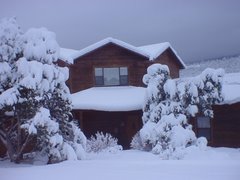May 17 continued
Ronald Reagan's hometown, Dixon, IL sits astride the Rock River. We continued a few miles up river to Grand Detour, wondering why they called it that. Turns out that that is anglicized French for "Big Bend." The Rock River makes a sharp U at this point. The Indians said that the river is so beautiful that it just had to turn around to look at itself. Check it out.

Susie says, why are we going here? Because the John Deere Historic Site is here, I say. Susie’s recalling a New Zealand historic site that we were directed to only to find a small sign saying this is a historic site. Her expectations are low. But, this turns out to be quite a find, thanks particularly to Rick the blacksmith.
First of all, John Deere was a person, not just a tractor brand. Rick asks us, If John Deere was alive today, what would he be known for? The tractor, we say. Wrong, says Rick. He’d be known for being over 200 years old! He was born in 1804.
Well, we’ve already seen the introductory video so we know that Deere’s contribution to farming was the “mould board plow.” We just played straightpersons for Rick. When John came to Grand Detour from Vermont in 1837 to set up a blacksmith shop, there was a problem: the cast iron plow that worked well in the sandy soil in the northeast couldn’t handle the Midwest’s thicker, gummier soil. The soil stuck to the blade and balled up and the plow wouldn’t plow. Deere’s solution was a highly polished, carefully curved, steel blade. It was self-cleaning. So, that’s why there are farms, not just prairie, in the Midwest today. The pioneers turned the soil, one furrow at a time, thanks to John Deere’s plow.
I asked about the term mould board. In my youth I had heard my grandpa Bennett and others talk about a mow-board plow. Didn’t know what that was and didn’t want to ask. There’s no good answer, Rick said. Earlier plows had a moulded board to which the cast iron blade was attached, so that seems the logical explanation. Deere replaced that assembly with a single curved steel piece, but didn’t change the name.
Business flourished and about 10 years later, Deere relocated to Moline, IL, on the Mississippi. He had been using a horse on a treadmill to power his shop. He could use river power in Moline (the Rock River wasn’t deep enough for a mill at Grand Detour). Rick told us that Deere created the assembly line long before Henry Ford. There are two of Deere’s original plows in existence: one at the Smithsonian, one at the Henry Ford Museum in Dearborn, MI.
Rick's story was interesting. He got into blacksmithing years ago because his wife owned horses. He became friends with the local blacksmith and worked with him part time. Then he got divorced and quit blacksmithing. He joined the Air Force and had a 20+ year career. Somehow he happened across the Deere Historical Site and found they were looking for a blacksmith. He took the job. He looks the part -- large guy with bushy beard -- and he puts on a show. After telling us the Deere story he showed us an iron rod and said there was a leaf inside just trying to get out. So, he pumped the bellows, heated the rod, and pounded out a leaf. You can see Rick's picture at the above Deere website.
First of all, John Deere was a person, not just a tractor brand. Rick asks us, If John Deere was alive today, what would he be known for? The tractor, we say. Wrong, says Rick. He’d be known for being over 200 years old! He was born in 1804.
Well, we’ve already seen the introductory video so we know that Deere’s contribution to farming was the “mould board plow.” We just played straightpersons for Rick. When John came to Grand Detour from Vermont in 1837 to set up a blacksmith shop, there was a problem: the cast iron plow that worked well in the sandy soil in the northeast couldn’t handle the Midwest’s thicker, gummier soil. The soil stuck to the blade and balled up and the plow wouldn’t plow. Deere’s solution was a highly polished, carefully curved, steel blade. It was self-cleaning. So, that’s why there are farms, not just prairie, in the Midwest today. The pioneers turned the soil, one furrow at a time, thanks to John Deere’s plow.
I asked about the term mould board. In my youth I had heard my grandpa Bennett and others talk about a mow-board plow. Didn’t know what that was and didn’t want to ask. There’s no good answer, Rick said. Earlier plows had a moulded board to which the cast iron blade was attached, so that seems the logical explanation. Deere replaced that assembly with a single curved steel piece, but didn’t change the name.
Business flourished and about 10 years later, Deere relocated to Moline, IL, on the Mississippi. He had been using a horse on a treadmill to power his shop. He could use river power in Moline (the Rock River wasn’t deep enough for a mill at Grand Detour). Rick told us that Deere created the assembly line long before Henry Ford. There are two of Deere’s original plows in existence: one at the Smithsonian, one at the Henry Ford Museum in Dearborn, MI.
Rick's story was interesting. He got into blacksmithing years ago because his wife owned horses. He became friends with the local blacksmith and worked with him part time. Then he got divorced and quit blacksmithing. He joined the Air Force and had a 20+ year career. Somehow he happened across the Deere Historical Site and found they were looking for a blacksmith. He took the job. He looks the part -- large guy with bushy beard -- and he puts on a show. After telling us the Deere story he showed us an iron rod and said there was a leaf inside just trying to get out. So, he pumped the bellows, heated the rod, and pounded out a leaf. You can see Rick's picture at the above Deere website.
At the Deere Historic Site, they have excavated and located his blacksmith shop. The house Deere built and lived in with his family is also on the site:
Also, the surrounding residential area in Grand Detour is really beautiful.
After this there was one more county courthouse to see, in Oregon, IL, then back to Amboy for dinner and back to Yogi Bear for the night. This was a day that we need to do more of. Pick a location and spend a day, or more, exploring it in detail. Don’t just pass through on the way to somewhere else.
Next stop: Dubuque, Iowa, just 150 miles up the road. We’ve decided to spend a couple of nights there before proceeding on to Ames on Sunday.
Cheers,
Rob and Susie










No comments:
Post a Comment